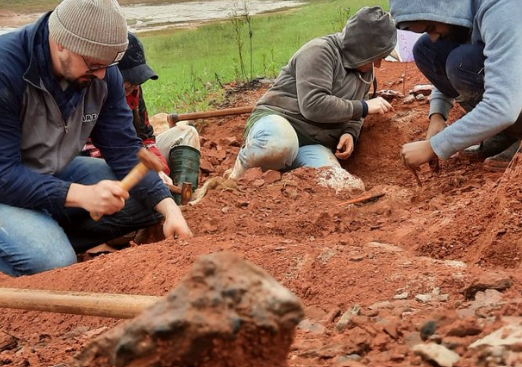Erosion caused by heavy rains in parts of Brazil earlier this year uncovered an “almost complete” skeleton of a dinosaur that lived about 233 million years ago during the Triassic Period, according to the Universidade Federal de Santa Maria.
The dinosaur is believed to be a carnivore and measured about 2.5 meters (8 feet, 2 inches) long, according to UFSM paleontologist Rodrigo Temp Müller, who led the team that discovered the fossil.
Erosion caused by heavy rains in parts of Brazil earlier this year uncovered an “almost complete” skeleton of a dinosaur that lived about 233 million years ago during the Triassic Period, according to the Universidade Federal de Santa Maria. https://t.co/vjAOMLjT2K
— FOX Weather (@foxweather) July 19, 2024
It was likely bipedal and had free hands, Müller noted. For reference, it was similar to a smaller version of the Allosaurus.
Müller added that the dinosaur belonged to a group known as Herrerasauridae, which included the first carnivorous dinosaurs. The fossil is the second-most complete Herrerasauridae specimen ever found, according to UFSM.
In fact, the dinosaur Müller and his team discovered would have predated perhaps the most well-known carnivorous dinosaur, Tyrannosaurus Rex, by at least 150 million years.
The discovery was made in late May in São João do Polêsine, which is located in the state of Rio Grande do Sul in the southern end of Brazil.
According to Müller, the site has been excavated by paleontologists for about 20 years, partially due to weather as a contributing factor to fossil discoveries.
“The rains expose the fossils regularly in this region,” he said to FOX Weather, noting how the fossils are encased in sedimentary rock that easily erodes.
“However, the last rains accelerated the erosion process,” he added.
Torrential rains bombarded the Rio Grande do Sul area in early May and caused historic flooding. More than 500,000 people were displaced and more than 100 people were killed as a result.
One of world’s oldest dinosaur fossils revealed by heavy rains in Brazil https://t.co/j3an51mepK
— Rhapsody Ryan (@rhapsodyryan6) July 20, 2024
UFSM noted that while excess rain can accelerate erosion occurring at the fossil site, it can also destroy the fossils if they are not rescued in time. Newly exposed fossils, particularly the smaller ones, become vulnerable to the elements and can even be destroyed in a single rain episode.
Now, Müller and his team will finish preparing the fossil recently revealed by the rains. These preparations include removing the bones from the rock to check the anatomical details of the specimen, which will help determine whether it is a new species of dinosaur.
Key Points:
- Heavy rains in Brazil uncovered an “almost complete” 233-million-year-old dinosaur skeleton during the Triassic Period.
- The carnivorous dinosaur, about 2.5 meters (8 feet, 2 inches) long, likely bipedal with free hands, is similar to a smaller version of the Allosaurus.
- It belongs to the Herrerasauridae group, the first carnivorous dinosaurs, and is the second-most complete specimen found.
- The discovery was made in late May in São João do Polêsine, Rio Grande do Sul, an area with frequent fossil finds due to erosion.
- Torrential rains in early May exposed the fossil but also risked destroying it, highlighting the urgency for its excavation.
Kirk Volo – Reprinted with permission of Whatfinger News



